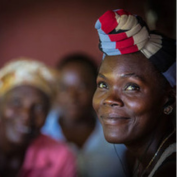The following Fonkoze CLM Insights focuses on our ultra-poverty alleviation program in Haiti. The series is written by Steven Werlin and highlights useful insights from the field that contribute to the development community. A full PDF of the data and tables referenced in the post can be accessed here:
CLM Insights – Maintaining CLM Graduates in VSLAs
How to Keep More CLM Members in VSLAs in Haiti
Challenge: Low retention rates by VSLAs (Village Savings and Loan Associations) of CLM graduates raise questions about the roles VSLA see themselves playing, their long-term viability, and the ability of CLM graduates to experience the positive socio-economic support that they offer.
Fonkoze’s Solution: Encouraging VSLAs to engage community agents and embedding them into the structure of Fonkoze’s VSLA operations.
Evidence of Success:
- CLM Graduate
retention - Growth of VSLA
member # in general - Growth of # of VSLA
groups - Financial growth of the VSLAs
Next Steps: This study suggests the value of incorporating these practices throughout Fonkoze VSLA practices.
The Challenge:
CLM Graduates Drop Out of Their VSLAs After the First Cycle
Given the positive social and economic roles that VSLAs can play in the lives of CLM graduates and their households, we have
viewed with concern a tendency of CLM members to leave their VSLAs. We saw an example of this in VSLAs established in and
around Wòch Milat, an area of northern Laskawobas, to serve a cohort of 150 CLM families.
Going into the second VSLA cycle for the associations, 50 CLM members dropped out,
leaving just 100 CLM participants out of 220 total VSLA members. This suggests and
important challenge: maintaining the VSLA’s orientation towards serving CLM families and,
so, bringing down the dropout rate for CLM families.
Despite the financial successes we have seen VSLAs achieve, a failure to prioritize CLM
families keeps them from achieving their goal within the CLM program, which is to provide
members and former members structured, if just semi-formal, access to financial services
that can increase their resilience and contribute to their growth. We believe that when
CLM members drop out of the VSLA structure, the chance that they will sustain the
progress they have made could decrease significantly. But the challenge of keeping CLM
families in the associations must be faced while strengthening the VSLAs themselves,
supporting them so that they remain strong associations long-term.
Fonkoze Innovation: Empowering Community Agents (CAs)
In this context, Fonkoze implemented an innovative intervention with VSLAs sponsored by
the W. K. Kellogg Foundation in Southern Mibalè. The experiment was led by a CLM VSLA
Specialist, Martinière Jasmin. The intervention included various elements:
- Recruitment and integration of Community Agents. This creates a new layer of actors
strengthening VSLAs, who are not CLM staff. - VSLA payment of CAs. These actors are not paid by CLM but by the VSLAs
themselves. VSLA members must be convinced that it is worth their while to do so. - CLM provision of training, materials, refresher sessions, and ongoing coaching
for CAs. CLM makes resources and staff time available that enable CAs to succeed
and even grow in their role. - CA promotion of engagement and conversation with VSLA leaders. The CA ability
to engage VSLAs and their leaders becomes the essential core.
Results: VSLAs Increased Their CLM Membership
Initially, the W. K. Kellogg Foundation-supported VSLAs followed the same negative trend as described above: the number of
CLM members decreased between the first and second cycles, even if only slightly (see “Year 2” in Table 2 below). But CLM’s
VSLA Specialist and the cohort of VSLA CAs that he created identified the problem quickly and made it a focus of their work. As
can be seen in “Year 3” of Table 2 below, the trend reversed. Entering the third cycle, the number of participanting former CLM
members had increased by 18% over the number who joined at the start.
Discussion: The Significance of the Components
Although summarized succinctly above, a few key points merit further discussion.
u Recruitment and involvement of Community Agents. An adequate
educational level might be important for CAs, but their other qualities may be
more important still. Their ability to convincingly engage VSLA members and
their elected leaders is key.
- CLMs role: Direct Manager to Facilitator. By creating a layer of CAs, CLM
VSLA Specialists were able to focus on coaching fewer key people even as
they oversaw greater numbers of VSLAs. - CLM role: Training, resources, empowerment. CLM can provide a number of resources for CAs: refresher trainings (with
and through the CAs), various resources that CAs can use as they engage their various VSLAs. Ultimately, it helps CAs to
become entrepreneurs by giving them a source of insights, strategies, wisdom that CAs can refer to as they face various
issues in various VSLAs. - VSLA Payment of CAs. A variety of approaches were taken: payment could be through deduction from the solidarity
fund of the VSLAs or direct payment by individual VSLA members from their end-of-cycle pay-out. Regardless of how this
was done, perhaps the two most notable aspects of this are—- VSLAs paying for their own Community Agents How VSLAs can be convinced that this is to their own interest to
pay for their CA will continue to be key. - The structure of this payment provides positive incentives for CAs to grow VSLAs numbers. CAs, in effect,
become entrepreneurs, growing a positive social impact entity in multiple locations for remuneration. There may be
some weaknesses to guard against at some point, the initial and overall direction seems quite positive.
- VSLAs paying for their own Community Agents How VSLAs can be convinced that this is to their own interest to
Next Steps: Recommended: Incorporation into Fonkoze’s VSLA Operations
Fonkoze now will incorporate this innovation into standard operations
for all VSLAs. In order to achieve this, it may be useful to systematically
answer the following questions:
1. To what extent did the success of this innovation depend on
the character and skills of the specialist who implemented it?
Can others find the same success?
2. What is the key to convincing VSLAs to pay for their own CAs?
3. How many VSLAs can or should CAs manage?
4. Are the current resources sufficient for the problems CAs face
as they engage VSLAs? Are there additional training topics or
materials that could or should be prepared?
5. What new costing would this model suggest for expanding
Fonkoze/CLM’s VSLA work?
6. What are the key elements for deep collaboration between
CLM’s VSLA Specialists and the CAs? How can this be
enhanced?
7. What are the key elements for deep collaboration between
CAs, and VSLAs and their leaders? How can this be
enhanced?
8. What are the key ingredients for maximum effectiveness of
the refresher sessions?
For more information or to suggest a topic: Contact Steven Werlin at swerlin@fonkoze.org.
Fonkoze/Chemin Lavi Mayò | Avenue Christophe 119, Pòtoprens, Haiti| +509 36.59.06.01 | www.fonkoze.org
Access the full report here: CLM Insights – Maintaining CLM Graduates in VSLAs





